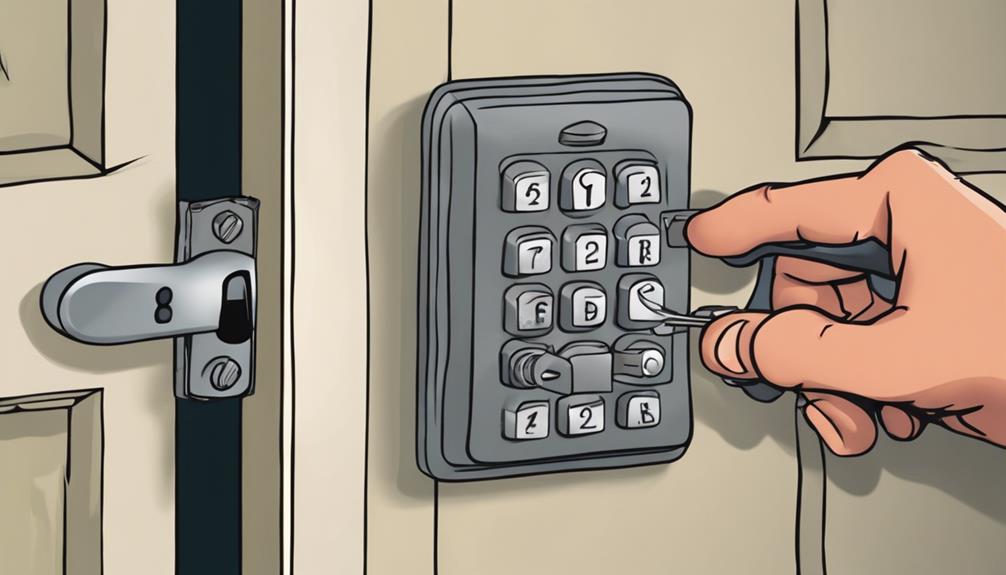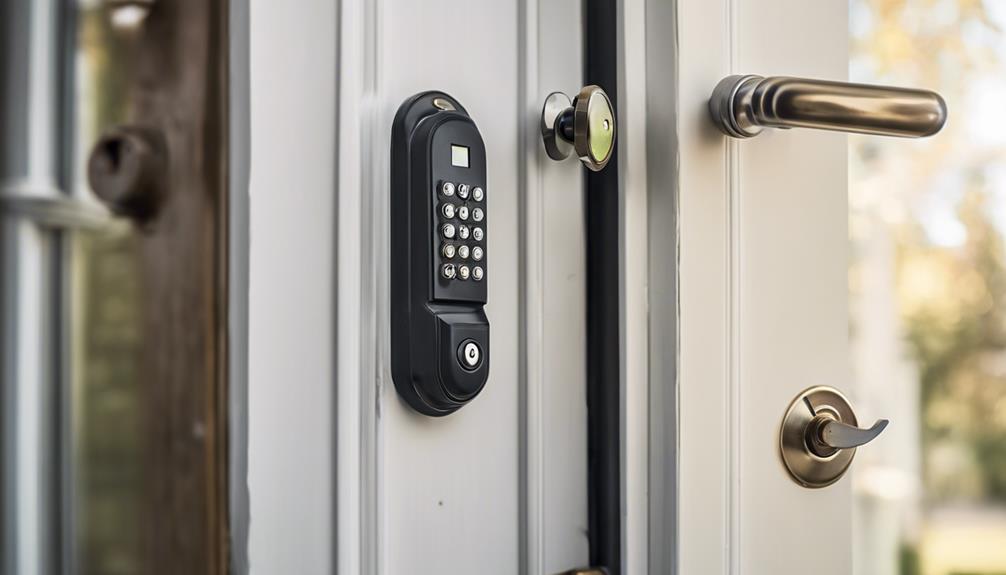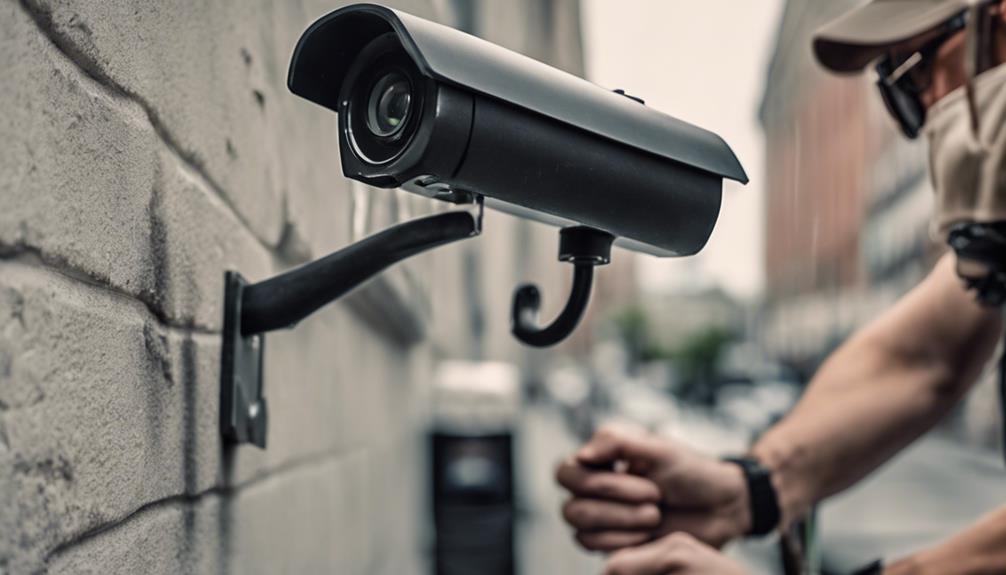Many locks on the market create an illusion of security. Attractive designs and superficial features often mask critical vulnerabilities. Cheap padlocks with low-quality materials can be picked or cut easily. Grade 3 deadbolts, lacking robust security mechanisms, are susceptible to basic tools. Even seemingly secure locks can falter without advanced internal designs. Professional locksmiths, like those at Low Rate Locksmith, offer expert insights to distinguish genuine security from mere appearances. They emphasize the importance of high-grade locks to truly protect properties. Stay informed on choosing the right locks to guarantee true peace of mind and explore the nuances of real security solutions.
Introduction

In today’s market, not all locks offer the robust protection they promise, leading to an unsettling illusion of security. This article aims to uncover the critical differences between high-quality and low-quality deadbolts, emphasizing the importance of making informed choices for safeguarding your property. By understanding these distinctions, you can guarantee that your security measures are genuinely effective and not merely superficial.
Brief overview of the importance of secure locks
Secure locks serve as the first line of defense against unauthorized access, making them indispensable for the protection of homes and businesses alike. High-quality locks are designed to deter burglars, providing property owners with unparalleled peace of mind. These robust mechanisms not only safeguard valuables but also create a secure environment for occupants. However, not all locks offer the same level of protection; some merely give the illusion of security. Understanding the critical differences between genuinely secure locks and their inferior counterparts is pivotal for making informed security decisions. Investing in locks that feature advanced security mechanisms is a proactive measure to guarantee that properties remain well-protected from break-in attempts, thereby empowering owners with true control over their security.
Explanation of the concept of “illusion of security”
Frequently, locks that provide the illusion of security appear robust and reliable at first glance, yet upon closer examination, they reveal critical vulnerabilities that can be easily exploited by intruders. This concept underscores the superficial confidence instilled by such locks; while they may look sturdy and well-constructed, they often lack essential security features. Weak internal mechanisms are a common flaw, making these locks susceptible to picking and other forms of attack. For individuals seeking control over their security environment, understanding the illusion of security is paramount. It equips them with the knowledge to identify and avoid locks that merely appear secure, ensuring they select options that genuinely protect their properties from unauthorized access.
Purpose of the article
Understanding the true security capabilities of locks is essential for homeowners and businesses alike, as this article aims to shine a light on the often-overlooked vulnerabilities that can compromise safety. Despite their aesthetically pleasing designs, many locks fail to provide robust protection due to inferior internal mechanisms. This article seeks to reveal how such locks, while deterring opportunistic criminals, fall short against determined intruders using sophisticated techniques. By dissecting the disparity between appearance and functionality, we hope to empower readers to make informed decisions about their security systems. Our goal is to highlight the critical need for truly secure locks, ensuring that the false sense of security provided by substandard locks does not leave properties vulnerable to intrusion.
Understanding the Illusion of Security

Understanding the illusion of security in the context of locks begins with recognizing how superficial features can mislead consumers into feeling protected. People often fall for insecure locks due to persuasive marketing and the psychological comfort provided by a visible barrier. This perceived security can be dangerous, as it may cause homeowners to underestimate potential risks and neglect more robust security measures.
What does “illusion of security” mean in the context of locks?
In the domain of home security, the term ‘illusion of security‘ refers to a deceptive sense of safety provided by locks that appear robust but can be easily bypassed by even rudimentary tools. This phenomenon is prevalent with common low-quality deadbolts that are often installed in many homes. These locks give homeowners a false confidence that their property is secure, when, in reality, they offer minimal resistance to unauthorized entry. The illusion of security can be particularly vital, as it may prevent individuals from taking necessary precautions to genuinely protect their homes. Understanding this concept is essential for making informed decisions about lock choices, ensuring that one’s sense of security is based on genuine protection rather than mere appearances.
Common reasons why people fall for insecure locks
A significant factor contributing to the widespread reliance on insecure locks is the persuasive allure of their aesthetically pleasing designs, which often overshadow the critical evaluation of their actual security capabilities. Decorative elements and attractive finishes can mislead consumers into believing they are purchasing robust security solutions. In reality, these locks frequently use low-quality materials that appear sturdy but offer minimal protection against break-ins. Moreover, some insecure locks imitate high-security features externally while lacking the internal mechanisms necessary to withstand forced entry. False marketing claims further compound the issue, promoting these locks as reliable, thereby deceiving consumers. This convergence of visual appeal and misleading information creates a potent illusion of security, leaving many unaware of their vulnerability.
The psychology behind perceived security
Revealing the complexities behind perceived security shows how visual cues, brand trust, and pricing strategies can greatly impact consumer confidence in lock efficacy, often overshadowing the true robustness of the lock’s internal mechanisms. Consumers frequently equate a lock’s solid appearance with invulnerability, a misconception amplified by reputable brands and premium pricing. This illusion can foster a false sense of safety, leading individuals to undervalue the importance of actual lock strength and security features. Aesthetically pleasing locks may deter opportunistic burglars but fail against determined intruders. By understanding these psychological factors, individuals can better navigate the market, prioritizing genuine security over superficial attributes, ensuring their homes and businesses are genuinely protected.
Cheap Padlocks

Cheap padlocks, while seemingly practical, often lack the advanced security features necessary to truly protect valuables, making them highly susceptible to picking and bypassing techniques. The use of low-quality materials and poor construction not only diminishes their durability but also provides a mere illusion of security that can mislead users into a false sense of protection. By examining the characteristics and vulnerabilities of these inexpensive locks, it becomes clear why investing in a high-quality padlock is essential for effective deterrence against unauthorized access.
Characteristics of cheap padlocks
In examining the characteristics of low-cost padlocks, one quickly discovers that the use of substandard materials greatly compromises their security. These padlocks often feature low-quality metals that can be easily bypassed using basic tools. Their simple keyways lack complexity, making them susceptible to quick picking. Additionally, the poorly constructed shackles can be effortlessly cut using bolt cutters. The absence of advanced security mechanisms, such as anti-drilling or anti-picking features, further exacerbates their vulnerability. For individuals seeking robust protection, these deficiencies highlight the critical flaws inherent in cheap padlocks. Their construction and design fail to meet the rigorous standards necessary for effective security, thereby undermining the control one desires over their valuable possessions.
Why they give a false sense of security
Frequently overlooked in security assessments, low-cost padlocks often project a deceptive aura of reliability, masking their inherent vulnerabilities. These inexpensive locks generally lack sophisticated security features, rendering them susceptible to picking, bumping, and shimming. The materials used are typically substandard, easily breaking under forceful entry attempts, thereby compromising their effectiveness. Standard pin tumbler mechanisms, common in cheap padlocks, can be swiftly bypassed even by novice lock pickers. Consequently, their apparent security is more an illusion rooted in appearance rather than actual resistance to unauthorized access. The widespread availability and affordability of these padlocks further contribute to a misplaced confidence, exposing users to significant security risks. For true security, investing in higher-quality solutions is paramount.
Real-world examples and vulnerabilities
Despite their seemingly secure design, numerous real-world examples reveal that inexpensive padlocks are alarmingly easy to breach due to their inherent vulnerabilities. Picking, shimming, and bypass techniques are often effortlessly employed against these low-cost options. The absence of features like hardened steel shackles or anti-pick pins further exacerbates their weaknesses. Compounded by the use of low-quality materials, these padlocks can be forcefully manipulated or broken with minimal effort. Additionally, many of these padlocks possess easily removable cores, which allow unauthorized access without a key. The illusion of security they provide is shattered by the ease with which experienced individuals can compromise them, underscoring the importance of investing in higher-quality locks for genuine protection.
Low-Quality Deadbolts

Low-quality deadbolts, often designated as Grade 3, lack the essential security features found in their higher-grade counterparts, making them vulnerable to forced entry with basic tools. Identifying these inferior deadbolts involves examining their construction materials and testing their resistance to common breach methods. The risks of relying on substandard deadbolts cannot be overemphasized, as they greatly compromise the safety of residential properties.
Differences between high-quality and low-quality deadbolts
Many Grade 3 deadbolts, which are considered low-quality, lack the robust security features that are essential for effectively protecting a property. These deadbolts can be easily bypassed using basic tools such as hammers and screwdrivers, rendering them insufficient against determined intruders. In stark contrast, high-quality deadbolts, like Grade 2 commercial deadbolts, are designed to impede unauthorized access more effectively. They feature a protective shroud that obstructs movement out of the door and shields the latch, making forced entry much more challenging. In addition, high-quality deadbolts aim to increase the noise and effort required for a break-in, drawing attention and deterring potential burglars. Investing in higher-grade deadbolts is paramount for those seeking genuine security and control.
How to identify a low-quality deadbolt
One of the key indicators of a low-quality deadbolt is the absence of robust security features designed to withstand common break-in techniques. Typically, these are Grade 3 deadbolts, often found in new constructions. They lack essential security measures and can be bypassed with basic tools like a hammer and screwdriver. Look for deadbolts without a protective shroud, which leaves them vulnerable to tampering. Additionally, their construction materials are usually of lower quality, compromising durability. Identifying these deficiencies is essential for those desiring control over their property’s security. Upgrading from a Grade 3 to a Grade 2 commercial deadbolt can greatly enhance protection, making break-in attempts noisy and attention-drawing, effectively deterring potential intruders.
Risks associated with using inferior deadbolts
Inferior deadbolts, particularly those of Grade 3 quality, present significant security vulnerabilities that can easily be exploited by intruders using rudimentary tools. These low-quality deadbolts lack advanced security mechanisms such as shrouds, making them susceptible to simple attacks with a hammer and screwdriver. Unlike high-quality deadbolts, which are designed to make forced entry noisy and noticeable, Grade 3 deadbolts offer minimal resistance, thereby compromising home security. It is important to recognize that knob locks alone are insufficient for protecting entry points. Investing in robust, high-grade deadbolts is vital to bolster security and deter burglars effectively. By prioritizing quality, homeowners can maintain control over their safety and ensure their property remains a fortress against unauthorized access.
Spring Latch Locks

Spring latch locks, frequently used in residential environments, offer convenience but fall short in providing robust security. Their susceptibility to tools like credit cards highlights significant vulnerabilities that can be exploited for unauthorized entry. For those seeking enhanced protection, exploring more secure alternatives is essential.
Overview of spring latch locks and their common uses
Widely utilized in residential settings, spring latch locks, or latchbolt locks, offer the convenience of automatic locking upon door closure, yet their simplistic design renders them vulnerable to various bypass techniques. Embraced for their ease of use, these locks eliminate the need for a key to secure the door, making them a popular choice for bedrooms, bathrooms, and entry-level security doors. Their swift operation provides immediate access and closure, appealing to homeowners seeking functionality and speed. Despite their convenience, it is essential to recognize that spring latch locks are not fortified against more determined intrusions. As a result, they are best suited for internal doors where high security is not a paramount concern. Understanding their limitations enables more informed security decisions.
Weaknesses of spring latch mechanisms
Despite the popularity of spring latch locks for their convenience, it is imperative to acknowledge their significant vulnerabilities that compromise overall security. These mechanisms are alarmingly susceptible to bypass techniques, such as slipping a card or small tool between the door frame and latch to effortlessly open the door. Such locks can be defeated without specialized tools, rendering them highly prone to break-ins. Additionally, methods like shimmying or jiggling the latch further highlight their weaknesses. Unlike deadbolts, spring latch locks lack robust resistance against physical attacks, making them an unreliable choice for safeguarding your home. This inherent frailty underscores the need for more secure alternatives to secure true protection and peace of mind.
Alternatives for better security
In order to enhance the security of your home, it is imperative to explore robust alternatives to spring latch locks that offer greater resistance to forced entry and unauthorized access. Deadbolts, for instance, provide a significant upgrade in security. Unlike spring latch locks, deadbolts extend a solid metal bolt deep into the door frame, making them much harder to manipulate or force open. Additionally, consider high-security locks with features like anti-pick pins and drill-resistant housings. Smart locks also offer advanced security, combining traditional mechanical locking mechanisms with electronic access controls. These options not only enhance physical security but also provide peace of mind, empowering homeowners with superior control over their property’s safety.
Standard Chain Locks

Standard chain locks are frequently used for added privacy on doors, yet they offer little in the way of actual security. Their inherent design flaws make them susceptible to being bypassed with simple tools, rendering them ineffective against determined intruders. To enhance safety, it is advisable to explore more robust alternatives that provide genuine protection.
Typical use cases for chain locks
Chain locks, often found in both residential and hospitality settings, serve as a quick and temporary security measure for doors, providing an added layer of convenience. They are typically installed in homes to allow occupants to partially open doors for safe communication with visitors without fully opening the door. In hotels, these locks enable guests to feel an additional sense of security when inside their rooms. Chain locks also appeal to property owners for their ease of installation and minimal cost. Despite their simplicity, they fulfill a niche need for temporary safeguarding. However, their primary role is to supplement more robust security measures, ensuring that occupants can feel a modicum of control over entry access in various scenarios.
Security limitations of standard chain locks
In addition, standard chain locks exhibit significant security limitations that undermine their effectiveness in protecting against unauthorized entry. Vulnerable to brute force attacks, these locks can be easily broken with a strong pull or kick. Typically made of weak materials, they provide a false sense of security and can be quickly compromised. Moreover, standard chain locks lack resistance to common burglary techniques such as drilling or cutting, rendering them unreliable for securing doors. Despite their appearance, they offer minimal protection against determined intruders. The limited security offered by these locks underscores the critical need to invest in more robust and secure locking mechanisms, ensuring enhanced protection and peace of mind for property owners.
Recommendations for more secure options
Investing in more advanced locking mechanisms, such as deadbolts or smart locks, is vital for greatly enhancing the security of your property. Standard chain locks, often seen on hotel room doors, provide only a false sense of security against intruders. These locks can be easily bypassed with rudimentary tools like rubber bands or plastic cards, rendering them ineffective. Despite their appearance of strength, standard chain locks offer minimal protection. Intruders can exploit the gap between the door and the frame to defeat standard chain locks without much effort. Upgrading to deadbolts, which offer robust resistance against forced entry, or smart locks, which provide advanced security features, is important for ensuring the true safety of your property.
Basic Keypad Locks

Basic keypad locks, while offering the convenience of code-based entry, present significant security vulnerabilities due to their limited combinations and susceptibility to brute force attacks. The perceived safety of these locks often leads users to overlook critical risks, such as code observation and the use of common default codes. To enhance security, it is imperative to consider more sophisticated electronic locks with advanced features like randomized keypads and multi-factor authentication.
Features of basic keypad locks
Keypad locks offer a straightforward entry mechanism through numerical code input, making them a convenient choice for many residential users. These locks excel in simplicity and ease of use, eliminating the need for physical keys and thereby reducing the risk of lockouts. Typically, basic keypad locks do not feature advanced security enhancements like biometrics or Bluetooth connectivity, which may make them less appealing to those requiring higher security levels. However, their straightforward design often fits the needs of homeowners seeking moderate security. Despite their limited customization options for user codes, which can restrict flexibility, they remain a practical solution for many. Their prevalence in residential settings underscores their user-friendly nature and the balance they strike between convenience and security.
Potential security flaws and hacking risks
The security vulnerabilities of basic keypad locks are often underestimated, yet they present significant risks due to predictable codes, lack of encryption, and absence of advanced anti-tamper features. Many basic keypad locks use weak or default codes that can be easily guessed or exploited by individuals with rudimentary hacking skills. The lack of encryption means that signals can be intercepted and manipulated without much effort. Additionally, these locks often permit unlimited entry attempts, making brute-force attacks feasible. The absence of sophisticated anti-tamper mechanisms further exacerbates their susceptibility to skilled hackers. Understanding these inherent limitations is crucial for anyone seeking to enhance their security measures and avoid the pitfalls of relying on these ostensibly secure devices.
Tips for choosing more secure electronic locks
When selecting a more secure electronic lock, it is imperative to prioritize models that integrate robust encryption protocols and advanced anti-tamper features to mitigate potential security vulnerabilities. Basic keypad locks offer the convenience of keyless entry, but their effectiveness hinges on the sophistication of their security measures. Opt for locks with strong encryption to guarantee that codes cannot be easily intercepted or decoded by malicious actors. Additionally, anti-tamper mechanisms are vital in preventing physical manipulation. Thoroughly research and choose locks with a proven track record of reliability and security. By making informed decisions, you can enjoy the benefits of keyless convenience without compromising on safety, ensuring that your electronic lock serves as a true barrier against unauthorized access.
Inadequate Smart Locks

In the domain of smart locks, certain models fall short, offering convenience at the expense of security. Poor design and software vulnerabilities can render these locks susceptible to physical tampering and cyber attacks, undermining their intended purpose. To fortify your defenses, it is essential to understand the common pitfalls of inadequate smart locks and adhere to stringent guidelines when selecting a reliable device.
Common types of inadequate smart locks
Surprisingly, many smart locks on the market today fail to deliver robust security due to a combination of weak encryption, inadequate physical defenses, and outdated firmware. Some models lack proper encryption, making them easy prey for hackers. Additionally, several locks feature weak physical security, which can be easily tampered with or bypassed. A significant number of these devices come with default passwords that users often neglect to change, posing a glaring security risk. Moreover, many inadequate smart locks do not receive regular firmware updates, leaving them vulnerable to known exploits. Insecure communication protocols further exacerbate these issues, making unauthorized access a real threat. For those seeking true security, it’s imperative to scrutinize these aspects diligently.
How poor design and software can lead to vulnerabilities
How can the intricate interplay of poor design and deficient software render smart locks alarmingly vulnerable to cyber threats? Smart locks with inadequate encryption protocols can be easily bypassed, leading to unauthorized access. The absence of regular software updates compounds this risk, leaving known vulnerabilities unpatched and exploitable by hackers. Poorly designed smart locks often lack robust security measures, enabling manipulation of access controls and giving users a false sense of security. This dangerous combination not only jeopardizes physical security but also exposes users to potential data breaches. Understanding these vulnerabilities is crucial for anyone seeking to maintain control over their security infrastructure, ensuring that the digital convenience of smart locks does not come at the expense of safety.
Guidelines for selecting reliable smart locks
When selecting reliable smart locks, it is vital to prioritize robust security features and seamless integration with smart home systems to guarantee both digital and physical safety. Prioritize smart locks equipped with advanced encryption to thwart hacking attempts and safeguard personal data. Make sure the lock supports regular firmware updates and secure authentication methods, such as biometric verification or multi-factor authentication, to enhance cyber security. Physically, the lock should have tamper-resistant mechanisms, including resistance to lock picking and drilling. Additionally, choose smart locks that integrate fully with your complete smart home security system, ensuring an interconnected defense strategy. By focusing on these critical aspects, you can select a smart lock that provides genuine security rather than an illusion.
Fake Surveillance Systems

Fake surveillance systems, such as dummy cameras, are often employed to create a semblance of security, but they lack the capability to record or deter actual criminal activities. While these devices may initially seem like a cost-effective solution, they can be perilous by fostering a false sense of safety, leaving properties vulnerable. Investing in genuine surveillance systems, which actively monitor and deter intruders, offers a far more reliable and effective safeguard against potential threats.
The role of fake surveillance in perceived security
The strategic deployment of fake surveillance systems can greatly enhance the perceived security of an area, creating a psychological barrier for potential intruders. Dummy cameras, fake alarm boxes, and motion sensor lights project an image of vigilance, often reducing the likelihood of break-ins. Studies reveal that visible security apparatus, even if non-functional, can effectively deter opportunistic criminals. This illusion of security is particularly advantageous in low-risk areas where the investment in real surveillance may be unwarranted. Enthusiastically embraced for their cost-effectiveness, these systems provide property owners a sense of control over their environment. While they may not thwart determined intruders, their presence can serve as a potent psychological deterrent, bolstering the overall security strategy.
Why fake cameras and alarms can be dangerous
Relying on pseudo-security measures like fake cameras and alarms can unwittingly create a dangerous false sense of security, leaving properties exposed to genuine threats. Criminals, often adept at identifying these superficial systems, recognize their ineffectiveness and are not deterred. Unlike real surveillance systems, fake counterparts lack monitoring and recording capabilities, meaning no actual evidence is captured during a breach. This vulnerability can have severe repercussions, especially when an actual security threat arises. For property owners who crave control and assurance, investing in legitimate security measures is imperative. The illusion of safety provided by fake systems can lead to complacency, ultimately compromising the very security they aim to protect. Real threats demand real solutions.
Benefits of investing in real surveillance systems
Why settle for an illusion when investing in real surveillance systems provides tangible security benefits that can greatly enhance the safety and peace of mind for property owners? Real surveillance systems offer functionalities such as video recording and remote monitoring, ensuring that every corner of your property is effectively overseen. Unlike fake systems, real ones can notify authorities in real-time, provide clear video evidence, and assist in identifying suspects, making them invaluable in crime prevention. Their reliability and effectiveness in monitoring assure property owners of genuine protection. By choosing a real surveillance system, you not only deter potential intruders but also equip yourself with the tools needed to respond swiftly and decisively to any security threats.
How to Identify Secure Locks

When identifying secure locks, it is vital to look for key features such as a Grade 1 security rating, reinforced strike plates, and high-strength steel bolts. Certifications like UL 437 provide assurance that the lock meets stringent security standards, while consulting experienced locksmiths can offer invaluable insights into the most reliable options. By focusing on these factors, you can guarantee that the locks you choose offer genuine protection rather than just the illusion of security.
Key features to look for in a secure lock
Identifying a secure lock requires an understanding of specific key features such as ANSI/BHMA Grade 1 certification, reinforced strike plates, pick-resistant technology, hardened steel components, and UL 437 rating for key control. Grade 1 certification ensures the highest level of security and durability, while reinforced strike plates with long screws offer superior resistance to forced entry. Pick-resistant technology, including mushroom or spool pins, greatly increases protection against lock picking. Additionally, hardened steel bolts and anti-drill plates are essential for withstanding physical attacks. Finally, a UL 437 rating guarantees key control and resistance to unauthorized key duplication, ensuring that your lock cannot be easily compromised. Prioritizing these features will provide robust security and peace of mind.
Certifications and standards to consider
Understanding the certifications and standards that govern lock security is essential for ensuring you select a lock that provides genuine protection. Locks certified by the American National Standards Institute (ANSI) and the Builders Hardware Manufacturers Association (BHMA) are recognized for their rigorous security benchmarks. Grade 1 locks, the pinnacle of these certifications, undergo extensive testing to withstand various forms of attack, ensuring superior durability and security. Additionally, components of Grade 1 locks are UL-certified, underscoring their resilience against extreme force and abuse. While Grade 1 locks surpass Grade 2 and Grade 3 in security features, it is important to remain vigilant, as vulnerabilities can still exist. Continuous assessments and updates in lock technology are crucial for maintaining top-notch security.
Advice from experienced locksmiths on choosing reliable locks
Experienced locksmiths emphasize that the cornerstone of selecting a reliable lock lies in recognizing the hallmarks of robust construction and advanced security features. Look for locks with Grade 1 certification, which guarantees exceptional durability and resistance to attacks. Secure locks boast anti-drill plates and hardened steel construction, ensuring they withstand aggressive attempts at forced entry. High-security bolts and reinforced strike plates are visible indicators of quality. Additionally, patented keyways or restricted key systems offer superior protection against unauthorized duplication. Avoid locks with plastic components or flimsy construction, as these often provide a deceptive sense of security. The right choice involves scrutinizing these critical features to guarantee the lock’s reliability and effectiveness in safeguarding your property.
The Role of Professional Locksmiths

Professional locksmiths are essential in ensuring robust security, as they possess the expertise to identify and rectify vulnerabilities in locks. Consulting a locksmith before purchasing locks is vital, as they can recommend high-quality options tailored to specific security needs. Services from reputable firms like Low Rate Locksmith provide thorough solutions to safeguard properties effectively.
How professional locksmiths can help in enhancing security
By meticulously evaluating the vulnerabilities in your existing security setup, locksmiths can provide invaluable insights and recommendations to fortify your defenses. Their expert advice on upgrading to more secure locks and systems guarantees that your security measures are not merely superficial but robust and effective. With in-depth knowledge of the latest lock technologies, locksmiths can recommend the most effective options tailored to your specific needs. Customized security solutions, crafted by seasoned professionals, assure a higher level of protection for your home or business. This personalized approach not only addresses current weaknesses but also preempts future threats. Ultimately, the expertise of professional locksmiths is pivotal in transforming your security landscape from illusory to formidable.
Importance of consulting a locksmith before purchasing locks
Seeking the guidance of a locksmith before purchasing locks is crucial to guaranteeing that your security measures are both practical and genuinely effective. Professional locksmiths possess in-depth knowledge of various lock types, brands, and security standards. This expertise allows them to offer tailored advice that can prevent you from investing in products that merely create an illusion of security. By consulting a locksmith, you can evade misleading marketing tactics and focus on locks that provide actual protection against intruders. Their ability to assess your specific security needs ensures you choose the most appropriate and robust solutions, thereby enhancing your control over your property’s safety. Enlisting a locksmith’s expertise is a strategic step toward achieving genuine and reliable security.
Services offered by Low Rate Locksmith to ensure optimal security
Utilizing the expertise of a trusted locksmith can greatly enhance your property’s security, and Low Rate Locksmith offers a wide range of services designed to guarantee maximum protection for both residential and commercial clients. From thorough lock installation, repair, and rekeying, to meticulous security assessments pinpointing vulnerabilities, their services are crafted with precision. Their professional locksmiths provide valuable insights on advanced security measures, including master key systems and high-security lock installations. Additionally, Low Rate Locksmith offers emergency lockout assistance, key duplication, and key cutting services, ensuring convenience alongside robust security. Entrusting your security needs to Low Rate Locksmith ensures you are not merely relying on the illusion of security, but on solid, professional assurance.
Conclusion

In summary, relying on low-quality locks can dangerously mislead homeowners regarding their property’s security. Prioritizing robust security measures, such as high-quality deadbolts, is essential for genuine protection. To ensure optimal safety, it is imperative to seek professional locksmith advice tailored specifically to your security needs.
Recap of key points discussed
Although the initial investment in high-quality Grade 2 deadbolts might be higher, the enhanced protection and peace of mind they provide make them an indispensable choice for securing entry points effectively. Our discussion elucidated the stark differences between low-quality and high-quality deadbolts, emphasizing that Grade 3 locks, commonly found in residential settings, lack the robustness needed to thwart potential intrusions. Conversely, Grade 2 commercial locks offer superior security features, including shrouds that prevent tampering. It is clear that the primary security level on any door hinges on the reliability of its deadbolt. By opting for Grade 2 deadbolts, one can significantly strengthen the security of their premises, thereby deterring burglars and safeguarding valuable assets.
Final thoughts on the importance of real security over perceived security
Recognizing the distinction between perceived security and real security is essential to ensuring that our homes and businesses are genuinely protected against potential threats. Low-quality locks often provide a deceptive sense of safety, leaving properties exposed to break-ins. High-quality locks, such as Grade 2 deadbolts, incorporate robust features that effectively deter intruders. Understanding this difference empowers homeowners to make informed decisions, aligning their security investments with the value of their assets. Real security measures focus on making unauthorized entry noisy and challenging, thereby safeguarding both belongings and lives. Ultimately, prioritizing genuine security over mere perception is vital for achieving true peace of mind and ensuring that protective measures meet the actual risks faced.
Encouragement to seek professional advice for securing homes and properties
To truly fortify our homes and businesses against potential threats, leveraging the expertise of professional locksmiths can provide invaluable insights and tailored solutions that elevate our security beyond the core of safety. Professional locksmiths are adept at identifying vulnerabilities and recommending robust security measures specifically designed to meet individual needs. Their training enables them to assess security risks thoroughly, ensuring that the implemented solutions are both effective and reliable. By consulting a locksmith, homeowners can avoid the pitfall of relying on locks that offer minimal protection and instead make informed decisions to safeguard their belongings and loved ones. In summary, seeking professional advice is essential for achieving genuine security and peace of mind.
Related Services by Low Rate Locksmith

For those seeking cost-effective solutions, Low Rate Locksmith offers an array of residential locksmith services, including emergency consultations and installations. However, to supplement these services, it is crucial to combine them with insights from articles on high-security locks and surveillance systems to guarantee complete protection. Contact Low Rate Locksmith for personalized consultations and immediate assistance, highlighting the importance of balancing affordability with genuine security.
Links to residential locksmith services
In light of the critical importance of robust security, Low Rate Locksmith offers specialized residential locksmith services designed to replace low-quality deadbolts with high-grade locking systems, ensuring your home is genuinely protected. Their expert technicians meticulously upgrade inferior locks from brands like Design House, Defiant, and Brinks, which often fail to deter intruders. By installing Grade 2 commercial locks, Low Rate Locksmith greatly enhances your door’s primary security level. This service is particularly essential for homeowners who value the safety of their belongings and loved ones. With their thorough approach, Low Rate Locksmith provides an insightful assessment of your current security measures and recommends tailored solutions to eliminate the illusion of security, giving you true peace of mind.
Links to articles on high-security locks and surveillance systems
Uncovering the unparalleled benefits of high-security locks and advanced surveillance systems can greatly enhance the protection of your home, providing a robust defense against potential threats. High-security locks offer superior resistance to picking, bumping, and drilling, making unauthorized entry exceedingly difficult. Meanwhile, sophisticated surveillance systems provide real-time monitoring and recording, guaranteeing you have eyes on every corner of your property. When used in tandem, these advanced security measures not only act as powerful deterrents to intruders but also offer invaluable peace of mind. Investing in these quality solutions guarantees your property is effectively safeguarded. For further insights, explore our recommended articles on high-security locks and surveillance systems, curated by Low Rate Locksmith to keep you informed and empowered.
Contact information for consultations and emergency services
Recognizing the critical importance of robust home security, Low Rate Locksmith offers thorough consultations and emergency services to guarantee your property is effectively protected. Our experienced locksmiths provide in-depth assessments, identifying potential vulnerabilities caused by low-quality locks that merely create an illusion of security. We focus on recommending and installing high-security locks tailored to your specific needs, ensuring both durability and resistance to break-ins.
For immediate assistance or to schedule a consultation, you can reach Low Rate Locksmith at (your phone number) or visit our website at (your website URL). Our team is available 24/7 to address any urgent lock-related issues, offering peace of mind and swift, professional service tailored to maintaining your control over home security.
Frequently Asked Questions
What Materials Are Best for High-Security Locks?
In the domain of high-security locks, materials are the foundation of protection. Hardened steel and brass are standard bearers, offering formidable resistance against tampering. Titanium and boron carbide elevate durability to an almost impenetrable fortress. Specialized alloys in pins, tumblers, and cylinders thwart manipulation, while reinforced steel plates fortify against forced entry. Choosing these advanced materials guarantees robust defense against picking, bumping, and drilling, granting unparalleled control over security.
Can a Locksmith Upgrade Existing Lock Systems?
Absolutely, a locksmith can upgrade existing lock systems to enhance security substantially. By replacing outdated locks with advanced options like Grade 1 deadbolts, which feature drill resistance and anti-pick pins, they provide robust protection. Additionally, locksmiths can install electronic, smart, or biometric locks tailored to your specific needs and budget. These upgrades not only fortify security but also provide invaluable peace of mind and a strong defense against potential break-ins.
How Does Lock Picking Differ From Bump Keying?
Lock picking and bump keying are distinct in their approach and skill requirements. Lock picking necessitates an in-depth understanding of a lock’s mechanics and the precise manipulation of pins, making it a skill-intensive process. Conversely, bump keying employs a specially cut key and a forceful bump to align the pins, offering a quicker and less subtle method. This forceful technique can potentially damage the lock, highlighting its aggressive nature.
Are Combination Locks More Secure Than Keyed Locks?
Are combination locks truly more secure than keyed locks? Combination locks can often provide a false sense of security due to their susceptibility to decoding and manipulation. Unlike keyed locks, which generally require more sophisticated techniques to bypass, combination locks can suffer from predictable patterns and default codes. For individuals seeking robust security, professional locksmiths consistently recommend opting for high-security keyed locks, which offer superior protection against unauthorized access.
What Are Some Signs of Tampering to Look Out For?
When examining for tampering signs, look for scratches, dents, or marks around the lock, which may indicate forced entry. Check for loose or misaligned components, suggesting interference. Any changes in the keyway or keyhole could signal manipulation. Additionally, if the lock feels different or harder to operate, it might have been tampered with. Finally, be wary of foreign objects, residue, or unusual substances near the lock, hinting at tampering.

